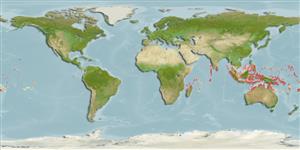>
Atheriniformes (Silversides) >
Atherinidae (Silversides) > Atherinomorinae
Etymology: Hypoatherina: Greek, hypo = under + Greek, atherina, the Greek name for the eperlane; 1770 (Ref. 45335).
Eponymy: Dr Clifford Adrian Barnes (1905-1995) was an American marine scientist who was Professor of Oceanography at the University of Washington, Seattle (1947–1973) his alma mater and Professor Emeritus after retirement. [...] (Ref. 128868), visit book page.
More on author: Schultz.
Environment: milieu / climate zone / depth range / distribution range
экология
морской ассоциированный с рифами; пределы глубины 0 - 5 m (Ref. 86942). Tropical; 12°N - 20°S
Indo-Pacific: East Africa to the northern Cook Islands, north to New Guinea and the Marshall Islands, south to northern Australia, New Caledonia and Fiji.
Size / Вес / Возраст
Maturity: Lm ? range ? - ? cm
Max length : 10.0 cm TL самец/пол неопределен; (Ref. 48635); common length : 4.0 cm TL самец/пол неопределен; (Ref. 2871)
колючие лучи спинного плавника (общее число) : 6 - 8; членистые (мягкие) лучи спинного плавника (общее число) : 8 - 12; колючие лучи анального плавника: 1; членистые (мягкие) лучи анального плавника: 12 - 17. Ascending process of premaxilla long and slender; ramus of dentary highly elevated posteriorly; midlateral band wide, broadest between anus and anal fin (Ref. 9760). First dorsal fin above middle of body; second dorsal fin originates behind the beginning of the anal fin; mid-lateral scales 40-43; transverse scales 5; predorsal scales 16-19 (Ref. 2334). Midlateral band width 2.3-3.3 in body depth (Ref. 37816).
Inhabits lagoons and along shorelines of outlying islands (Ref. 3302). During daylight, schooling fish may be periodically seen to jump out of the water to avoid predators. They are also easily attracted to light. The fish are gravid at about 4-4.5 cm SL by July in the northern hemisphere. Because of their large numbers, they are probably important as forage food for larger fishes (Ref. 9760).
Life cycle and mating behavior
половая зрелость | размножение | нерест | икра | Fecundity | личинки
Oviparous, distinct pairing during breeding (Ref. 205).
Ivantsoff, W., 1984. Atherinidae. In W. Fischer and G. Bianchi (eds.) FAO species identification sheets for fishery purposes. Western Indian Ocean fishing area 51. Vol. 1. (Ref. 3302)
Статус Красного Списка МСОП (Ref. 130435: Version 2024-1)
Угроза для людей
Harmless
Использование человеком
рыболовство: интереса не представляет
дополнительная информация
инструменты
Специальные отчеты
Скачать в формате XML
ресурсы в Интернет
Estimates based on models
Preferred temperature (Ref.
123201): 26.8 - 29.3, mean 28.6 °C (based on 1816 cells).
Phylogenetic diversity index (Ref.
82804): PD
50 = 0.5001 [Uniqueness, from 0.5 = low to 2.0 = high].
Bayesian length-weight: a=0.00562 (0.00240 - 0.01320), b=3.15 (2.95 - 3.35), in cm total length, based on LWR estimates for this (Sub)family-body shape (Ref.
93245).
Trophic level (Ref.
69278): 3.3 ±0.4 se; based on size and trophs of closest relatives
устойчивость к внешним воздействиям (Ref.
120179): высокий, минимальное время удвоения популяции до 15 месяцев (Preliminary K or Fecundity.).
Fishing Vulnerability (Ref.
59153): Low vulnerability (10 of 100).
Nutrients (Ref.
124155): Calcium = 127 [68, 248] mg/100g; Iron = 0.732 [0.406, 1.349] mg/100g; Protein = 19.5 [17.2, 21.8] %; Omega3 = 0.125 [0.054, 0.317] g/100g; Selenium = 16.1 [7.2, 38.6] μg/100g; VitaminA = 192 [57, 585] μg/100g; Zinc = 1.94 [1.27, 2.85] mg/100g (wet weight);
